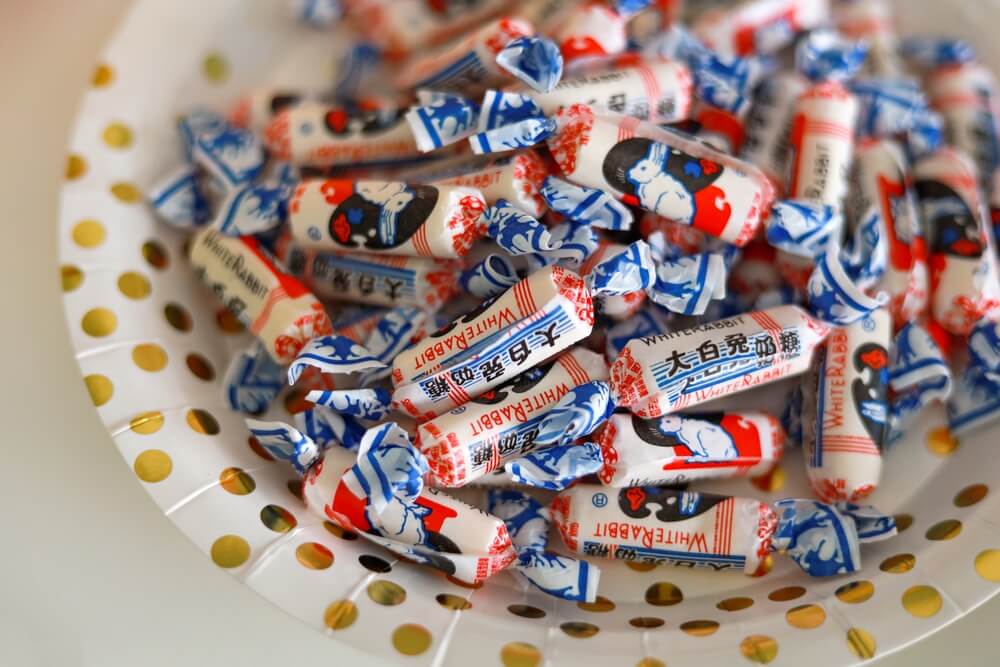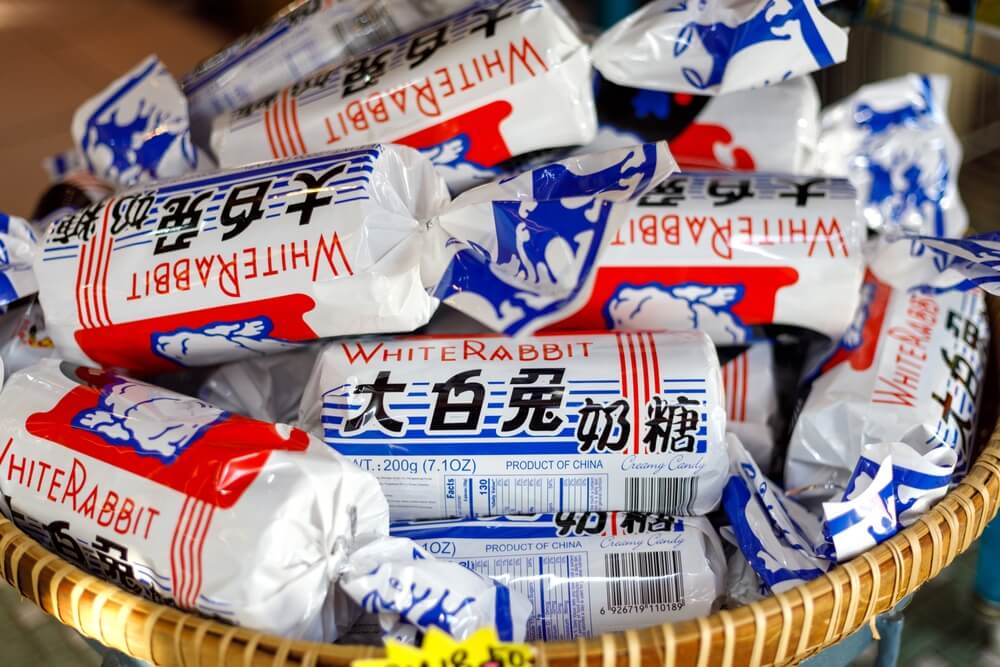White Rabbit Candy: A Sweet Journey Through Time and Taste
China’s #1 sweets product may have started from the humble regions of shanghai, but it’s a global brand today. White rabbit candy may be delicious and creamy but something more has propelled it to the very top of the industry. Let’s find out what!

Unwrapping the Legacy of White Rabbit Candy
White Rabbit candy was first created in Shanghai, China, by the ABC Candy Factory in 1943. This was during the Second World War. One of the company’s merchants had tasted an English milk candy and loved it. The experience led him to spend a year developing China’s first milk candy. Upon release, the company called it the ABC Mickey Mouse Sweet. The original label had a drawing of a red Mickey Mouse, hence the name. This was ideal packaging for children, and the company saw some success. The products were also delicious while being cheaper than imported milk candies. Perhaps we would still know the brand as a Mickey Mouse-themed candy today if not for government intervention.
In the 1950s, something happened to change the trajectory of the sweets brand. Many private Chinese companies were nationalized, and the ABC Candy Factory became state-owned. China’s sense of national pride was on the rise in this period, so it didn’t take long for the government to realize that Mickey Mouse was a foreign symbol. In 1959, they decided to revamp the entire branding strategy and use a white rabbit instead. This led to the creation of the iconic image we have come to know and love. They also understandably changed the name to White Candy Rabbit. ABC (then known as Ai-Ming) sold their company in 1976 to Guan Sheng Yuan Food Group, a state-run business that owns the brand to this day.
At the start, the candy was only popular in China. Today, it’s being distributed to over 40 countries. There are White Rabbit candy distributors in the US, Singapore, and parts of Europe. In China, the candy has become a part of their national identity. They offer it as gifts to visitors and seek the tasty treat even in diaspora. No other candy comes close, thanks to its unique texture and exceptional branding.

The Secret Behind White Rabbit Creamy Candy's Unique Texture
There have been several variants of the White Rabbit brand. However, the original version is by far the most beloved by consumers, particularly indigenous ones. The candy is made from milk and is in a small, cylindrical form. It has a chewy texture, which North Americans may compare to tootsie rolls. The actual milk candy is wrapped in rice paper to keep it from melting. This sticky rice paper is one of the brand’s biggest selling points. It creates a distinctive texture and is also 100% edible.
When listing the ingredients and food additives for White Rabbit candy, UK retailers refer to the inner wrapping as “Edible Glutinous Rice Paper” or “Ëdible Starch Paper,” containing cassava & corn starch, water, and glycerin monostearate. The number of people who don't know how to properly eat the candy will surprise you. Their most common mistake is to peel the rice paper and throw it away. Here’s how to do it properly: After removing the outer wrapper, you can eat the candy and paper covering at once. For many, doing that makes it more delicious, as the edible paper enhances the chewy texture.
Although the White Rabbit sweets now have different flavors on the market, the presence of milk and edible rice paper is constant in all of them.
White Rabbit Candies: A Flavor for Every Palate
Another, vastly underrated reason for the candy’s global reach is how much it has diversified to appeal to different tastes and interests. There are over 18 different flavors, but many of them are rare. Some are common in certain countries and non-existent in others. We’ll highlight six of the most popular flavors available in the White Rabbit candy lineup.
-
Original Milk Flavor:
The classic product that led to global success. Made with milk and butter, this should be your go-to candy if you enjoy creamy flavors. Many people have been eating it since they were children, and we suspect a big part of its appeal is the feeling of nostalgia it provides.
-
Chocolate Flavor:
This one is a lot like the classic but contains a fair bit of chocolate. The chocolate flavor isn’t as strong as you might expect, considering its brown appearance. However, you can definitely taste it, particularly as an aftertaste. This flavor is just as creamy as the original White Rabbit.
-
Red Bean Flavor:
These taste like red bean paste. They are not as sweet as the original milk versions but the azuki red beans flavor satisfies a different palette. It goes well with teatime beverages.
-
Yogurt Flavor:
Mixed with the distinctive flavor of yogurt, you can tell that the manufacturers were going for the perfect balance between sweet and sour. This variant is slightly crunchier than the average White Rabbit.
-
Corn Flavor:
When you think of flavoring for creamy candy, corn doesn’t readily come to mind. The White Rabbit manufacturers managed to pull it off with these sweets. Behind the milky vanilla is the taste of sweet corn, which becomes more prominent as you continue to eat it.
-
Wasabi Flavor:
If you don’t know what wasabi is, here’s a quick definition: It’s a green plant used as a condiment for Japanese foods such as sushi and noodles. It’s pungent, hot, and spicy, with a sharp taste that’s not for everyone. Nevertheless, the company has created a wasabi-flavored candy, which is a feat that is as unusual as it is daring.
-
Other Flavors:
The Guan Sheng Yuan Food Group continues to produce more versions of this milky treat. Below are some of the rarer variants:
-
Mango
-
Coffee
-
Cool
-
Banana
-
Coconut milk
-
Durian
-
Peanut
-
Coconut
-
Matcha
-
Lychee
-
Fruit
-
Strawberry
The sheer number of varieties shows how far White Rabbit candy has come since its humble beginnings.

From Local Delight to Global Sensation: The Rise of White Rabbit.
How did the White Rabbit Sweets get to their current state? A lot has happened over the decades that has helped the brand become so big. Let’s trace the journey of White Rabbit candy from its origins to becoming a worldwide favorite.
1943: The candy was invented with the name “Mickey Mouse Sweets.”
1959: Official rebranding and launch of the sweets as “White Rabbit candy.”
1959: During China’s 10th National Day, the sweets were shared with the people as gifts.
1972: Richard Nixon, America’s 37th president, was presented with White Rabbit candies as gifts during his visit to China.
2004: Annual sales reached 600 million yuan.
2013: Launch of a new Guan Sheng Yuan factory in Shanghai, thereby scaling production.

The Art of Enjoying White Rabbit Creamy Candy
Did you know that there are other fun ways to enjoy these iconic candies besides popping them in your mouth? Check out our favorite below:
Melt it to make ice cream
With some milk, whipped cream, and lots of White Rabbit candies, you can make creamy ice cream. The process involves melting the candies in milk using a microwave before mixing them with heavy whipped cream.
Bake it into cookies
You can make White Rabbit cookies by breaking up the candies and baking them in dough. This recipe has become popular on social media.
Whip it in pudding
Using low heat, you can melt the candy in a mixture of cream, milk, and sugar. This is one of the steps for making White Rabbit pudding. Feel free to pour the hot mixture into molds to get your desired shapes.
Use it in latte
You can use the candy to make a creamy, sweet latte within a few minutes. Simply melt a few candies in milk tea over low heat and add a bit of frother.

White Rabbit in Modern Culture: More Than Just a Candy
Today, White Rabbit maintains its role in Asian and Asian-American culture. Families in China still give sweets to their visitors as gifts. And adults still enjoy the candies as treats that help them relive their childhood memories. Also, there have been several modern reinterpretations of White Rabbit candy in the last few years. Here are some of them:
-
Many companies are making reimagined versions of ice cream using White Rabbit candies as the base of their flavors.
-
The White Rabbit name and imagery have also been licensed to cosmetic brands as a way to market products such as lip balm, body lotion, and shower cream.
-
There’s an official White Candy milk
-
Designers use the brand logo on t-shirts, phone cases, and hand bags.
Is White Rabbit candy worth all of this hype? Yes, it is! The fact that it has been around for so many decades is testament to its high production quality. The downside to such vast success is the emergence of counterfeit candies using toxic substances. If you’d like to safely join in on the fun, you can buy White Rabbit candy from Bokksu Market. All the items in stock are 100% original. Get as many as you need. Your family and visitors will always appreciate a nutritious treat.
Author Bio








